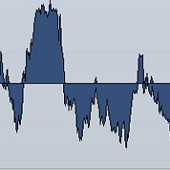 Why should I mix and master with a 24-bit, 96 kHz floating point system? Simply... it sounds better. Even if you master a 16-bit - 44.1 kHz track.
Why should I mix and master with a 24-bit, 96 kHz floating point system? Simply... it sounds better. Even if you master a 16-bit - 44.1 kHz track.
Why are 24 bits better?
If all the numbers below are spinning your head, just think of a painting in digitized form. With a low resolution, you get the idea of the picture, but it looks rough and grainy. With a higher resolution, the picture looks fine and smooth. With an extremely high resolution, the digitized print would almost identically resemble the original painting. 16-bit gives you 65,536 ‘pixels’, and 24-bit gives you over 16 Million ‘pixels’.
Technically speaking, the resolution of the audio signal in a 16-bit system is 65,536 steps. Each bit gives you 6 dB dynamics. In the ideal world, 16-bit would give your music 96 dB dynamics. In the real world, 1-2 bits = 6-12 dB are noise, and about 18dB = 3 bits have to be left as headroom to merge tracks, add EQ, etc. So a normal 16-bit recording is an 11-12 bit recording = 72 dB dynamics and 4,096 steps resolution.
The resolution of the audio signal in a 24-bit system is 16,777,216 steps. With 6dB dynamics per bit, 24-bit gives your audio a theoretical 144 dB dynamics. Subtract the 4 bits for noise and headroom and you have a usable resolution for your music of 20 bit = 120 dB dynamics.
Why is 96 kHz better?
It has to do with the Analog to Digital (A/D) converter. Mr. Nyquist found out that the sampling frequency of an A/D converter must be twice the audio frequency we want it to convert. Humans hear up to 18 kHz, give or take, unless they have ruined their ears in front of Marshall stacks, 147 Leslie’s, and other blasters.
So a converter with the traditional 44.1 or 48 kHz sampling rate can convert up to 22.05 of 24 kHz audio, well above what even a newborn can hear.
So why is 96 kHz better? To answer this question, we have to dig deeper. If an A/D converter receives frequencies that are above the Nyquist frequency (e.g. overtones at 30 kHz) it does not simply ignore them. It ‘folds’ them back into the audible frequency spectrum, resulting in false tones.
The solution to this problem is a filter in the analog part of the converter that filters all frequencies above 22 kHz, so they can’t fold back. These filters are called brick wall filters because they stand there like a brick wall that doesn’t let anything through. Unfortunately, small portions of the audio are bouncing back from this ‘wall’, creating so-called artifacts (turbulence/ distortion) in the high frequencies that are audible.
By raising the sampling frequency from 44.1 kHz to 96 kHz (audio from 22.05 to 48 kHz), the filter frequency can be raised too (from 22 kHz to approx. 35 kHz). The filter can be smoother (like tilting the wall). The back-bouncing gets reduced and only affects frequencies above 20 kHz.
What is that Float point thing all about?
Most of the 24-bit systems have their limitations as long as they are ‘fixed point’. The problem is that by lowering the volume of an audio signal (e.g. a fade out), the number of ‘active bits’ decreases (less one bit with every 6 dB less volume).
At minus 72 dB, a 16-bit system has approx. 2 bits left to describe (represent) the audio waveform.
A 24-bit fixed-point system has still approx. 10 bits left to describe (represent) the audio.
In a floating point system at any volume level between minus 760 dB and 760 dB, a 24-bit resolution is used.
How does that work??? Envision a ruler with 16, 20, or 24 inches, representing a 16, 20, and 24-bit system. In a fixed point system, the division between the 16, 20, and 24-bit (inches) is fixed (each inch = 1 bit). As the audio signal gets lower, the number of active bits used gets smaller. This degrades the audio quality of the signal. You can hear it on a CD that has a title with a fade out by turning up the volume during the fade out. The sound gets grainy.
If the audio signal extends the ‘length’ of the ruler, the signal clips. In a floating point system, the divisions are flexible, as if they were written on a very flexible rubber band. The rubber band shrinks or expands with the audio level of each sample. In other words, as the audio lever gets lower, the rubber band shrinks but still uses all 24 divisions (bits).
If the audio level gets higher, the rubber band is stretching (no clipping). The rubber band can shrink down to -760 dB and stretch up to the dynamic level of + 760 dB giving you total dynamics of 1520 dB and unprecedented audio quality. Almost all digital audio recording and editing systems and digital mixers use fixed-point systems.
Why should I record, edit, mix, and master with a 24-bit, 96 kHz floating point system?
Remember… it sounds better. Even if you master a 16-bit, 44.1 kHz track. We can’t prove it in writing, so trust your ears. You also want to keep a master in a 24-bit 96 kHz float to be ready when the industry leaders make up their minds.
Last but not least, there is the enjoyment of unprecedented audio quality from an analog or a digital system. Isn’t that why you started to record music in the first place?
